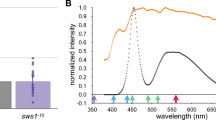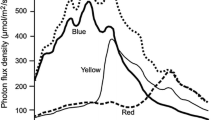Abstract
To effectively introduce light-emitting diode (LED) lights into Japanese flying squid Todarodes pacificus fisheries, information is required regarding how LED lights affect physiological responses of the squid eye. In order to examine the effects of LED emission-color on squid eyes, we observed the pupillary constriction and migration of black-screening pigment in the retina. The pupils constricted in all squid after exposure to LED lights; the pupils gradually opened and pigment migration occurred. Both of the physiological responses to LED light were affected by blue, green, and white lights, which have wavelengths close to the visual pigment sensitivity peak in T. pacificus (482 nm). However, response rates were much lower under red colored LED, which comprises wavelengths that are far from the visual pigment sensitivity peak. Thus, the eyes of squid responded sensitively to light which included the wavelengths close to the visual pigment sensitivity peak of T. pacificus and responded little to the light which did not include these wavelengths. These results suggest that the eyes of T. pacificus react in different ways to various LED light colors, where the first reaction to a lighting change is the pupillary response, and pigment migration occurs only if the illumination continues.






Similar content being viewed by others
References
Arakawa H, Choi S, Arimoto T, Nakamura Y (1998) Relationship between underwater irradiance and distribution of Japanese common squid under fishing lights of a squid jigging boat. Fish Sci 64:553–557
Hasegawa K (2008) Annual fuel oil consumptions of Japanese fishing vessels. Tech Rep Natl Res Inst Fish Eng 30:9–15 (in Japanese with English abstract)
Arimoto T, Choi S, Arakawa H (2003) Syuugyotou gijutsu. In: Arimoto T, Inada H (eds) Surumeika no sekai—shigen, gyogyou, riyou [The World of Japanese Common Squid (Todarodes pacificus) Resources, Fishery and Utilization]. Seizando Shoten Publishing Co. Ltd, Tokyo, pp 203–221 (in Japanese)
Matushita Y, Yamashita Y (2012) Effect of a stepwise lighting method termed “stage reduced lighting” using LED and metal halide fishing lamps in the Japanese common squid jigging fishery. Fish Sci 78:977–983
Yamashita Y, Matsushita Y, Azuno T (2012) Catch performance of coastal squid jigging boats using LED panels in combination with metal halide lamps. Fish Res 113:182–189
Shikata T, Yamashita K, Shirata M, Machida Y (2012) Performance evaluation of fishing lamp using oval-shaped blue LEDs for squid jigging fishery in offshore fishing grounds in the Sea of Japan. Nippon Suisan Gakkaishi 78:1104–1111 (in Japanese with English abstract)
Hanlon RT, Messenger JB (1996) Sense, effectors and the brain. In: Hanlon RT, Messenger JB (eds) Cephalopod behaviour. Cambridge University Press, Cambridge, pp 12–30
Nilsson DE (2004) Eye evolution: a question of genetic promiscuity. Curr Opin Neurobiol 14:407–414
Hanlon RT, Messenger JB (1996) Feeding and foraging. In: Hanlon RT, Messenger JB (eds) Cephalopod behaviour. Cambridge University Press, Cambridge, pp 47–65
Suzuki T, Inada H, Takahashi H (1985) Retinal adaptation of Japanese common squid (Todarodes pacificus Steenstrup) to light changes. Bull Fac Fish Hokkaido Univ 36:191–199
Inada H (1996) Retinomotor response and retinal adaptation of Japanese common squid Todarodes pacificus at capture with jigs. Fish Sci 62:663–669
Seidou M, Sugahara M, Uchiyama H, Hiraki K, Hamanaka T, Michinomae M, Yoshihara K, Kito Y (1990) On the three visual pigments in the retina of the firefly squid, Watasenia scintillans. J Comp Physiol A 166:769–773
Jeong H, Yoo S, Lee J, An Y-I (2013) The retinular responses of common squid Todarodes pacificus for energy efficient fishing lamp using LED. Renew Energy 54:101–104
Makino A, Miyazaki T (2010) Topographical distribution of visual cell nuclei in the retina in relation to the habitat of five species of Decapodiformes (Cephalopoda). J Molluscan Stud 76:180–185
Douglas RH, Williamson R, Wagner H-J (2005) The pupillary response of cephalopods. J Exp Biol 208:261–265
McCormick LR, Cohen JH (2012) Pupil light reflex in the Atlantic brief squid, Lolliguncula brevis. J Exp Biol 215:2677–2683
Roper CFE, Sweeney MJ, Nauen CE (1984) 3. Cuttlefishes (Order Sepioidea). In: Roper CFE et al (ed) FAO species catalogue Vol. 3. Cephalopods of the World. An annotated and illustrated catalogue of species of interest to fisheries. FAO Fish Synop No. 125, Vol 3, FAO, Rome, pp 27–78
Roper CFE, Nigmatullin C, Jereb P (2010) Family Loliginidae Lesueur, 1821. In: Jereb P, Roper CFE (eds) Cephalopods of the world. An annotated and illustrated catalogue of cephalopod species known to date. Vol 2. Myopsid and Oegopsid Squids. FAO Species Catalogue for Fishery Purpose. No. 4, vol 2. FAO, Rome, pp 38–117
Ackleson SG (2003) Light in shallow waters: a brief research review. Limnol Oceanogr 48:323–328
Roper CFE, Nigmatullin C, Jereb P (2010) Family Ommastrephidae Steenstrup, 1857. In: Jereb P, Roper CFE (eds) Cephalopods of the world. An annotated and illustrated catalogue of cephalopod species known to date. Volume 2. Myopsid and oegopsid squids. FAO Species Catalogue for Fishery Purpose. No 4, vol 2. FAO, Rome, pp 269–347
Sakurai Y, Kidokoro H, Yamashita N, Yamamoto J, Uchikawa K, Takahara H (2013) Todarodes pacificus, Japanese common squid. In: Rosa R et al (eds) Advances in squid biology, ecology and fisheries part II—oegopsid squids. Nova Science Publishers Inc, New York, pp 249–271
Kawabata A, Yatsu A, Ueno Y, Suyama S, Kurita Y (2006) Spatial distribution of the Japanese common squid, Todarodes pacificus, during its northward migration in the western North Pacific Ocean. Fish Oceanogr 15:113–124
Douglas RH, Harper RD, Case JF (1998) The pupil response of a teleost fish, Porichthys notatus: description and comparison to other species. Vision Res 38:2697–2710
MacIsaac D, Kanner G, Anderson G (1999) Basic physics of the incandescent lamp (lightbulb). Phys Teach 37:520–525
Zhang X, Hu L, He M-X (2009) Scattering by pure seawater: effect of salinity. Opt Express 17:5698–5710
Acknowledgments
We would like to thank Akebono-Suisan, Hakodate, Japan, for providing the live squid. We would also like to thank H. Inada and J. Yamamoto for their valuable advice during the research activities. We gratefully acknowledge D. Vijai for his comments on the manuscript.
Author information
Authors and Affiliations
Corresponding author
Rights and permissions
About this article
Cite this article
Matsui, H., Takayama, G. & Sakurai, Y. Physiological response of the eye to different colored light-emitting diodes in Japanese flying squid Todarodes pacificus . Fish Sci 82, 303–309 (2016). https://doi.org/10.1007/s12562-015-0965-5
Received:
Accepted:
Published:
Issue Date:
DOI: https://doi.org/10.1007/s12562-015-0965-5




